What is EPDM Rubber Roofing?
EPDM (Ethylene Propylene Diene Monomer) roofing is a synthetic rubber membrane widely recognised as one of the most durable and cost-effective flat roofing solutions available today. This single-ply roofing membrane has been used successfully across the UK for over 50 years, protecting both residential and commercial properties from the elements.
Unlike traditional felt roofing systems, EPDM rubber roofing consists of a continuous waterproof membrane that's either mechanically fastened, fully adhered, or ballasted to the roof deck. The material itself is remarkably flexible, allowing it to expand and contract with temperature changes without cracking or splitting—a common failure point in older roofing materials.
At Knights Roofing, we've installed hundreds of EPDM rubber roofing systems across London, from small domestic extensions to large commercial buildings. Our experience has shown that when properly installed, EPDM roofing consistently outperforms many alternative flat roofing materials in terms of longevity and maintenance requirements.

Why Choose EPDM Rubber Roofing?
Exceptional Durability and Longevity
EPDM rubber roofing systems typically last 40-50 years when properly installed and maintained—significantly longer than traditional felt roofing which may need replacing every 10-15 years. The material is engineered to withstand UV radiation, ozone exposure, and temperature extremes ranging from -40°C to +120°C without degradation.
The single-ply membrane construction eliminates the multiple layers found in traditional built-up roofing systems, reducing potential failure points. This durability translates directly into long-term cost savings, as property owners face fewer repairs and avoid the expense and disruption of premature roof replacement.
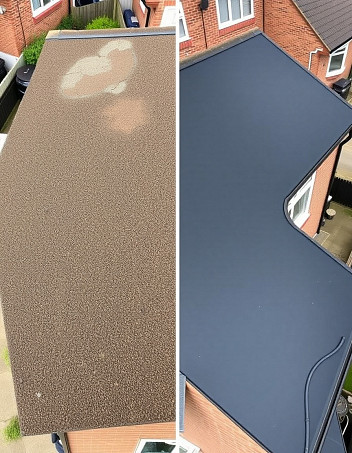
Weather Resistance
British weather can be particularly challenging for roofing systems, with frequent rain, temperature fluctuations, and occasional severe weather events. EPDM rubber roofing excels in these conditions due to its inherent water resistance and flexibility. The membrane remains elastic throughout its service life, accommodating building movement and thermal expansion without splitting or developing leaks.
According to the National Federation of Roofing Contractors (NFRC), properly installed EPDM systems demonstrate excellent performance in the UK climate, with minimal maintenance requirements compared to alternative flat roofing solutions.
Low Maintenance Requirements
Once installed, EPDM rubber roofing requires minimal ongoing maintenance. The smooth, non-porous surface resists algae and moss growth, which commonly affect other roofing materials. An annual inspection and occasional cleaning are typically sufficient to maintain the roof's integrity and appearance.
Our flat roof maintenance services include EPDM inspection and minor repairs, helping extend the life of your rubber roofing system even further.
Cost-Effective Solution
While EPDM rubber roofing may have a higher initial cost than basic felt roofing, the long-term economics are compelling. When you factor in the extended lifespan, reduced maintenance costs, and improved energy efficiency, EPDM typically offers better value over its lifetime.
For homeowners and businesses planning to remain in their property long-term, EPDM roofing represents a sound investment that eliminates the recurring costs associated with short-lived roofing materials.
Environmentally Friendly
EPDM is an environmentally responsible roofing choice. The material is recyclable at the end of its service life, and its long lifespan means less frequent roof replacements, reducing construction waste. Additionally, EPDM's reflective properties can contribute to improved building energy efficiency, particularly when light-coloured membranes are used.
How Much Does EPDM Rubber Roofing Cost?
EPDM roofing costs in London typically range from £50 to £90 per square metre for a complete installation, depending on several factors:
Factors affecting cost:
- Roof size and complexity: Larger roofs benefit from economies of scale, while complex shapes with multiple penetrations increase labour costs
- Access difficulties: Roofs requiring scaffolding or working at height equipment will incur additional costs
- Insulation requirements: Adding or upgrading insulation beneath the EPDM membrane improves energy efficiency but increases overall project cost
- Edge details: Parapet walls, coping stones, and upstands require additional materials and specialist labour
- Substrate preparation: Damaged roof decks may need repair or replacement before EPDM installation
For a typical domestic flat roof (approximately 20m²) on a single-storey extension, expect to pay between £1,500-£2,500 including all materials, labour, and guarantees. Commercial projects are quoted individually based on specific requirements.
At Knights Roofing, we provide detailed written quotations that clearly break down all costs, so you understand exactly what you're paying for. Our 20+ years of experience means we can accurately assess your project requirements and provide realistic costings without hidden surprises.
EPDM vs Other Flat Roofing Materials
EPDM vs Traditional Felt Roofing
Traditional torch-on felt roofing has been the standard flat roofing solution for decades, but EPDM offers several advantages:
Lifespan: Felt roofing typically lasts 10-20 years, while EPDM can exceed 40 years
Installation safety: EPDM doesn't require hot works (naked flames), reducing fire risk during installation
Maintenance: Felt roofs are prone to blistering and splitting, requiring more frequent repairs
Flexibility: EPDM remains flexible throughout its life, while felt becomes brittle with age
However, felt roofing remains a viable option for budget-conscious projects where longevity isn't the primary concern. Learn more about traditional flat roofing options in our comprehensive flat roofing guide.
EPDM vs GRP (Fibreglass) Roofing
GRP (Glass Reinforced Plastic) fibreglass roofing is another popular flat roof solution with distinct characteristics:
Seamless finish: GRP creates a completely seamless surface, while EPDM has seams (though these are fully welded)
Aesthetic options: GRP can be finished in various colours with an anti-slip texture
Installation time: EPDM can typically be installed faster than GRP
Cost: GRP is generally more expensive than EPDM per square metre
Repairs: EPDM repairs are generally simpler and more cost-effective
Both systems offer excellent performance, and the choice often comes down to specific project requirements, budget, and aesthetic preferences.
EPDM vs Single-Ply PVC
PVC single-ply roofing shares similarities with EPDM but differs in several ways:
Chemical resistance: EPDM has superior resistance to chemicals and oils
Installation: Both use similar installation methods
Cost: PVC is typically more expensive than EPDM
Environmental profile: EPDM is generally considered more environmentally friendly
The EPDM Installation Process
1. Initial Survey and Assessment
Professional EPDM installation begins with a thorough roof survey. Our experienced roofers assess the existing roof structure, identifying any issues that need addressing before installation. This includes checking:
- Structural integrity of the roof deck
- Condition of any existing roof covering
- Drainage adequacy and fall (slope) towards outlets
- Condition of upstands, parapets, and penetrations
- Insulation requirements
This assessment ensures we design the right solution for your specific property and identify any preparatory work required.
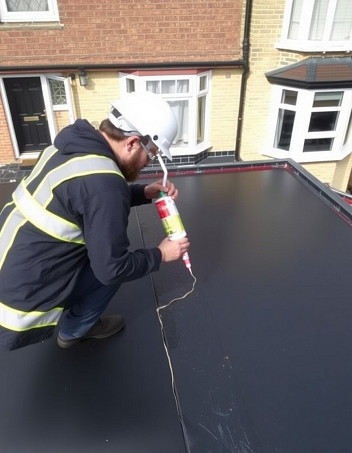
2. Roof Preparation
Proper preparation is critical to EPDM installation success. We remove any existing roof covering if necessary and repair or replace damaged roof boarding. The substrate must be clean, dry, and stable before EPDM installation begins.
If insulation is being installed or upgraded, we ensure it's properly fitted and secured, meeting current Building Regulations for thermal performance. Proper insulation not only improves energy efficiency but also provides a stable base for the EPDM membrane.
3. EPDM Membrane Installation
We unroll the EPDM membrane across the prepared roof surface, allowing it to relax and settle. The membrane is then trimmed to fit the exact roof dimensions, accounting for upstands and edge details.
Installation typically uses one of three methods:
Fully Adhered: The EPDM is bonded directly to the substrate using specialist adhesive, providing maximum wind uplift resistance
Mechanically Fastened: Fixing plates secure the membrane through to the roof deck, with cover strips protecting the fasteners
Ballasted: The membrane is held in place with gravel or paving slabs (suitable only for specific roof structures)
For most residential and commercial applications in London, we recommend fully adhered systems for optimal performance and wind resistance.
4. Seam and Edge Detailing
All seams between EPDM sheets are created using specialist tape or liquid adhesive, creating watertight bonds that match the membrane's durability. Proper seaming technique is crucial—poorly executed seams are the most common failure point in EPDM roofing systems.
Edge details require particular attention. The membrane must be properly terminated at roof edges, parapet walls, and around penetrations like vents and pipes. We use compatible flashings and cover strips to ensure these critical junctions remain watertight for decades.
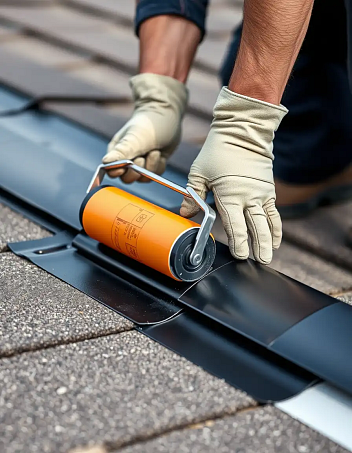
5. Final Inspection and Testing
After installation, we conduct a thorough inspection of all seams, edges, and penetrations. We check for proper drainage and ensure the finished installation meets all British Standards and manufacturer specifications.
All our EPDM installations come with comprehensive guarantees covering both materials and workmanship, giving you complete peace of mind.
When Should You Choose EPDM Roofing?
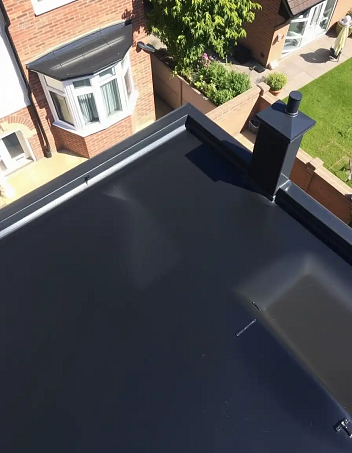
EPDM rubber roofing is particularly well-suited to:
Domestic extensions and garages: The long lifespan means homeowners won't need to worry about their flat roof for decades
Commercial buildings: Low maintenance requirements and durability make EPDM ideal for business properties where roof failures cause operational disruption
Outbuildings and garden rooms: EPDM provides reliable weather protection for structures that may not justify expensive roofing systems
Refurbishment projects: When existing flat roofs are reaching the end of their life, EPDM offers an excellent replacement option
New build projects: Architects and developers increasingly specify EPDM for its performance and longevity
EPDM may not be the best choice for roofs with very complex shapes involving numerous corners and penetrations, where the seaming work becomes extensive. In such cases, GRP fibreglass might offer advantages due to its seamless application.
Common EPDM Roofing Problems and Solutions
While EPDM roofing is highly reliable, issues can occasionally occur:
Seam Failure
Improperly installed or poorly maintained seams can develop leaks over time. This highlights the importance of choosing experienced EPDM installers who follow manufacturer guidelines precisely. At Knights Roofing, our installers are trained in proper seaming techniques and we use only approved adhesives and tapes.
If seam failure does occur, repairs are straightforward when addressed promptly. We can reinforce or remake seams without replacing the entire membrane.
Ponding Water
Standing water on flat roofs can reduce EPDM's lifespan and indicates inadequate drainage. While EPDM is waterproof, prolonged ponding can accelerate membrane degradation and creates unsightly marks.
The solution typically involves improving roof falls or enhancing drainage. This is why our initial surveys always assess drainage adequacy before installation.
Physical Damage
Like any roofing material, EPDM can be damaged by falling objects, foot traffic, or wildlife. The flexible nature of EPDM makes it relatively resistant to impact damage, but punctures can occur.
Fortunately, EPDM repairs are relatively simple and cost-effective. Small punctures can be patched using EPDM repair tape or liquid primers, while larger damaged areas may require membrane replacement in that section.
Our roof repair services cover all EPDM issues, from minor patches to more extensive repairs.
Maintaining Your EPDM Rubber Roof
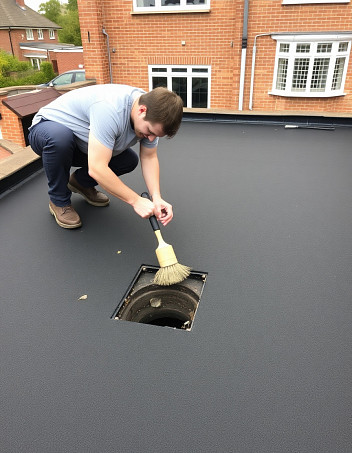
Regular maintenance extends your EPDM roof's lifespan and ensures optimal performance:
Annual inspections: Check for debris accumulation, drainage issues, and any visible damage. We offer professional inspection services if you're uncomfortable accessing your roof safely.
Keep drainage clear: Remove leaves and debris from gutters and outlets to prevent water backup
Gentle cleaning: Wash the roof surface annually using mild detergent and water to remove dirt and organic growth. Avoid harsh chemicals or high-pressure washers.
Prompt repairs: Address any identified issues quickly to prevent minor problems becoming major failures
Trim overhanging vegetation: Keep trees and shrubs trimmed back to prevent debris accumulation and reduce physical damage risk
According to the Flat Roofing Alliance, proper maintenance can add years to any flat roofing system's lifespan, with EPDM requiring less intervention than alternative materials.
Why Choose Knights Roofing for Your EPDM Installation?
Based in Battersea, Knights Roofing has over 20 years of experience installing EPDM rubber roofing systems across London and surrounding areas. We serve residential and commercial clients in Kensington, Richmond, Hammersmith, Fulham, Chiswick, Brent, and throughout West London.
Our EPDM roofing credentials:
- Family-run business: Every project receives personal attention and care
- Fully qualified installers: Our team is trained in proper EPDM installation techniques and follows manufacturer specifications precisely
- Comprehensive guarantees: All installations come with robust guarantees covering materials and workmanship
- Competitive pricing: We offer transparent, detailed quotations with no hidden costs
- Full service capability: From initial survey through to completion and aftercare, we handle every aspect of your project
- Safety focus: All work complies with health and safety regulations, with appropriate insurance coverage
We don't just install EPDM roofing—we're specialists across all roofing types, including pitched roofing,lead roofing, and traditional flat roof systems. This broad expertise means we can recommend the genuinely best solution for your property, not just the services we happen to offer.
Frequently Asked Questions About EPDM Roofing
How long does EPDM rubber roofing last?
When properly installed and maintained, EPDM roofing systems typically last 40-50 years. Some well-maintained EPDM roofs have exceeded 60 years of service life. This exceptional longevity is one of EPDM's primary advantages over alternative flat roofing materials.
Can EPDM roofing be installed over existing roofing?
In some cases, EPDM can be installed over an existing roof covering, but this depends on the condition of the existing roof and substrate. We generally recommend removing old roofing materials to ensure proper adhesion and allow inspection of the roof deck. This approach also avoids adding unnecessary weight to the roof structure.
Is EPDM roofing suitable for the UK climate?
Absolutely. EPDM has been used successfully in the UK for over 50 years and performs excellently in our climate. The material withstands temperature extremes, heavy rain, snow, and UV exposure without degradation. Its flexibility prevents cracking during freeze-thaw cycles that commonly damage more rigid roofing materials.
Can you walk on EPDM roofing?
Yes, EPDM roofing can withstand occasional foot traffic for maintenance purposes. However, flat roofs aren't designed as terraces or walkways unless specifically constructed for that purpose with additional protection. Always walk carefully on EPDM to avoid damaging the membrane with sharp objects.
How quickly can EPDM roofing be installed?
Installation speed depends on roof size and complexity. A typical domestic flat roof (20-30m²) can usually be completed in 2-3 days, including preparation and finishing. Larger commercial projects take longer but EPDM installation is generally faster than built-up roofing systems or GRP fibreglass.
Does EPDM roofing require planning permission?
For most domestic flat roof replacements, planning permission isn't required as it's considered maintenance and repair. However, if you're building a new extension or significantly altering your property's appearance, planning permission may be necessary. We recommend checking with your local planning authority if unsure.
What warranty comes with EPDM roofing?
EPDM membrane manufacturers typically provide material warranties of 20-25 years, though the expected lifespan is considerably longer. At Knights Roofing, we also provide comprehensive workmanship guarantees on all our installations, ensuring you're protected if any installation-related issues arise.
Getting Started with Your EPDM Roofing Project
If you're considering EPDM rubber roofing for your London property, Knights Roofing offers free, no-obligation surveys and quotations. We'll assess your roof, discuss your requirements, and provide honest, impartial advice on whether EPDM is the right solution for your needs.
Our transparent approach means you'll receive a detailed written quotation breaking down all costs, so you can make an informed decision. We never use high-pressure sales tactics—our reputation is built on quality workmanship and customer satisfaction, not pushy selling.
Contact Knights Roofing today to discuss your flat roofing needs. Whether you're replacing an existing roof, building a new extension, or seeking expert advice on the best roofing solution for your property, our experienced team is here to help.
Call us or visit our website to arrange your free roof survey and quotation. Let us show you why hundreds of London property owners trust Knights Roofing for their EPDM rubber roofing needs.



